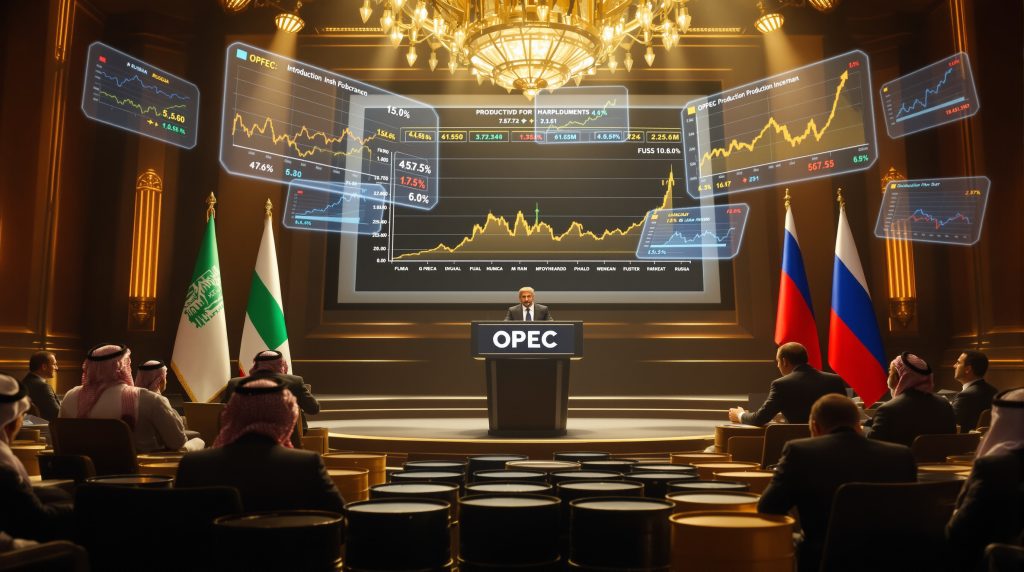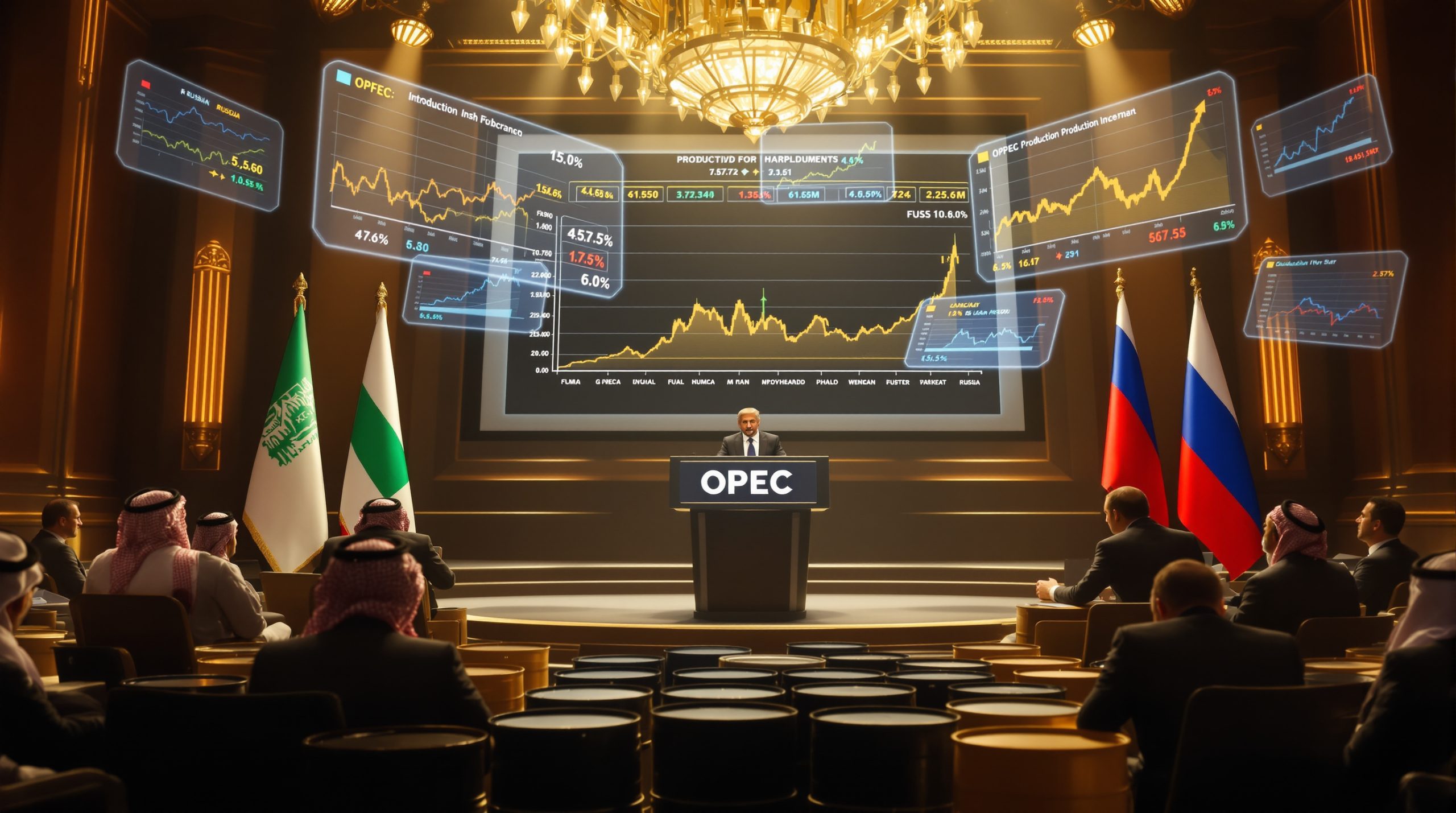OPEC Denies Reports of Major Output Increase: What's Really Happening?
OPEC recently issued a formal statement rejecting media reports claiming the organization was planning a significant increase in oil production. The official statement from the OPEC Secretariat described these reports as "wholly inaccurate and misleading," seeking to clarify their position ahead of the upcoming G8 meeting. This unusual public denial highlights the sensitive nature of production decisions and their impact on global markets, particularly in relation to the upcoming OPEC Meeting Impact.
The Context Behind OPEC's Statement
The denial came amid growing speculation about OPEC's production strategy, particularly as oil prices have shown volatility in recent weeks. Several financial publications had suggested that OPEC was preparing to announce a substantial output increase, which contributed to downward pressure on crude prices. The organization's swift response indicates its concern about market stability and price signals.
How Are Current OPEC+ Production Strategies Actually Unfolding?
Despite rejecting reports of a major production hike, OPEC+ has been implementing a gradual unwinding of previous production cuts since April 2024. This nuanced approach represents a careful balancing act rather than the dramatic shift suggested in recent media reports.
Incremental Production Increases vs. Major Hikes
The alliance has been methodically increasing output by approximately 180,000-200,000 barrels per day each month, following a strategy that acknowledges:
- Stronger-than-expected global demand recovery
- The need to maintain price stability
- Balancing market share considerations among member nations
Kuwait's Support for Measured Production Growth
Kuwait, a significant OPEC member, has publicly backed the current approach of gradual production increases. Kuwait's oil minister recently stated that robust global demand justifies these incremental output hikes, noting that OPEC+ members have sufficient spare capacity to meet market needs without destabilizing prices.
What Market Signals Are Driving OPEC's Cautious Approach?
Several key market indicators are influencing OPEC's current production strategy and its rejection of more aggressive output increases, including the recent oil price rally tied to global economic factors.
Table: Key Market Factors Influencing OPEC's Production Decisions
| Factor | Current Status | Impact on OPEC Strategy |
|---|---|---|
| Global Oil Demand | Stronger than initially forecast | Supports gradual production increases |
| Crude Inventories | Below 5-year average in many regions | Reduces pressure for major output hikes |
| Price Volatility | Increased in recent weeks | Encourages cautious, measured approach |
| Economic Growth | Mixed signals across major economies | Warrants flexibility in production plans |
| Geopolitical Tensions | Ongoing in several key regions | Adds premium to maintaining spare capacity |
The Resilience of Global Oil Demand
Despite earlier predictions of weakening demand, consumption has proven more resilient than many market analysts anticipated. This resilience provides OPEC+ with confidence to continue its measured approach to production increases without risking a price collapse.
How Are Oil Prices Responding to OPEC's Production Signals?
The market reaction to OPEC's denial of major production increases has been notable, with immediate price movements reflecting the importance of the organization's statements.
Recent Price Movements and Contributing Factors
Crude oil prices have experienced significant volatility, with Brent crude recently trading around $67 per barrel and WTI at approximately $62.50. This represents a decline of about 1.5% in recent trading sessions, influenced by:
- Conflicting signals about future OPEC+ production plans
- Economic data from major consuming nations
- Inventory reports showing mixed signals
- Broader market sentiment around inflation and interest rates
Additionally, trade war oil prices have shown particular sensitivity to international tensions and policy announcements.
Longer-Term Price Projections
While current prices reflect immediate market reactions, longer-term forecasts suggest potential downward pressure. Some analysts project Brent crude prices could decline to around $50 per barrel by early 2026 due to anticipated inventory builds and production increases from both OPEC+ and non-OPEC sources. Furthermore, analysts are closely watching for signs of oil price easing amid changing global trade policies.
What's Behind the Conflicting Market Narratives?
The contradiction between media reports and OPEC's official position highlights the complex dynamics at play in global oil markets.
Information Asymmetry in Oil Markets
Oil markets frequently experience conflicting narratives due to:
- Multiple sources with varying degrees of access to decision-makers
- Strategic information management by key players
- Different interpretations of similar data points
- Competing interests among market participants
The Challenge of Forecasting OPEC Decisions
Predicting OPEC's actions remains challenging because production decisions are influenced by a complex mix of:
- Economic considerations
- Political relationships between member states
- Strategic long-term market positioning
- Responses to non-OPEC production growth
- Domestic budgetary requirements of member nations
How Might OPEC's Production Strategy Evolve Through 2025?
Looking ahead, several factors will likely shape OPEC's approach to production management over the coming year.
Potential Scenarios for OPEC Production Strategy
-
Continued Gradual Unwinding: The most likely scenario based on current signals, with incremental monthly increases continuing through 2025.
-
Accelerated Production Growth: Possible if demand significantly exceeds expectations or if market share concerns become more prominent.
-
Production Pause or Reversal: Could occur if economic conditions deteriorate or if prices fall below comfort levels for key producers.
-
Differentiated Member Approaches: Increasing possibility of varying compliance levels among members based on individual capacity and economic needs.
Critical Factors That Will Influence Future Decisions
- Global economic growth trajectories
- The pace of energy transition investments
- Non-OPEC production growth, particularly from U.S. shale
- Geopolitical developments affecting major producers
- The evolution of transportation demand post-pandemic
- The potential tariffs economic impact on global trade and energy demand
What Does This Mean for Global Energy Markets?
OPEC's production decisions have far-reaching implications beyond immediate price movements, affecting energy security, investment decisions, and economic planning worldwide.
Broader Market Implications
-
Energy Security Planning: Countries are increasingly diversifying supply sources while maintaining strategic relationships with OPEC producers.
-
Investment Decisions: Oil companies must navigate uncertain price environments when making capital allocation decisions.
-
Consumer Economics: Transportation and manufacturing sectors continue to face uncertainty in input costs.
-
Energy Transition Timing: Price stability influences the pace of alternative energy adoption and fossil fuel divestment.
FAQ: Understanding OPEC Production Decisions
Why does OPEC publicly deny certain media reports about production?
OPEC issues denials when it believes market speculation could create unnecessary price volatility or misrepresent the organization's actual intentions. These statements help manage market expectations and maintain the group's credibility as the primary voice on its production policies.
How do OPEC production decisions affect global inflation?
Energy costs represent a significant component of consumer price indices in most economies. When OPEC restricts production and oil prices rise, this can contribute to broader inflation pressures, particularly in transportation, manufacturing, and food production sectors that rely heavily on petroleum inputs.
What's the difference between OPEC and OPEC+?
OPEC consists of 13 member countries primarily from the Middle East, Africa, and South America. OPEC+ includes these core members plus 10 additional oil-producing nations, most notably Russia, that coordinate production policies with OPEC to enhance market management effectiveness.
How much of global oil production does OPEC+ control?
OPEC+ members collectively control approximately 50-55% of global oil production and hold about 90% of proven oil reserves, giving the alliance significant influence over market conditions and pricing.
How do OPEC decisions affect non-member producers like the United States?
OPEC production decisions create price signals that influence investment and production decisions by non-member producers. Higher prices resulting from OPEC restraint typically stimulate increased production in countries like the United States, while lower prices can force production cuts and reduced investment.
Further Exploration:
Readers interested in learning more about OPEC's production strategies and oil market dynamics can also explore related educational content available at Reuters' energy coverage, which offers regular updates on global energy markets and OPEC decisions.
Want to Stay Ahead of the Next Major Resource Discovery?
Discovery Alert's proprietary Discovery IQ model delivers real-time notifications when significant mineral discoveries are announced on the ASX, giving investors a crucial market edge. Explore how historic discoveries have generated substantial returns by visiting the Discovery Alert discoveries page and start your 30-day free trial today.




